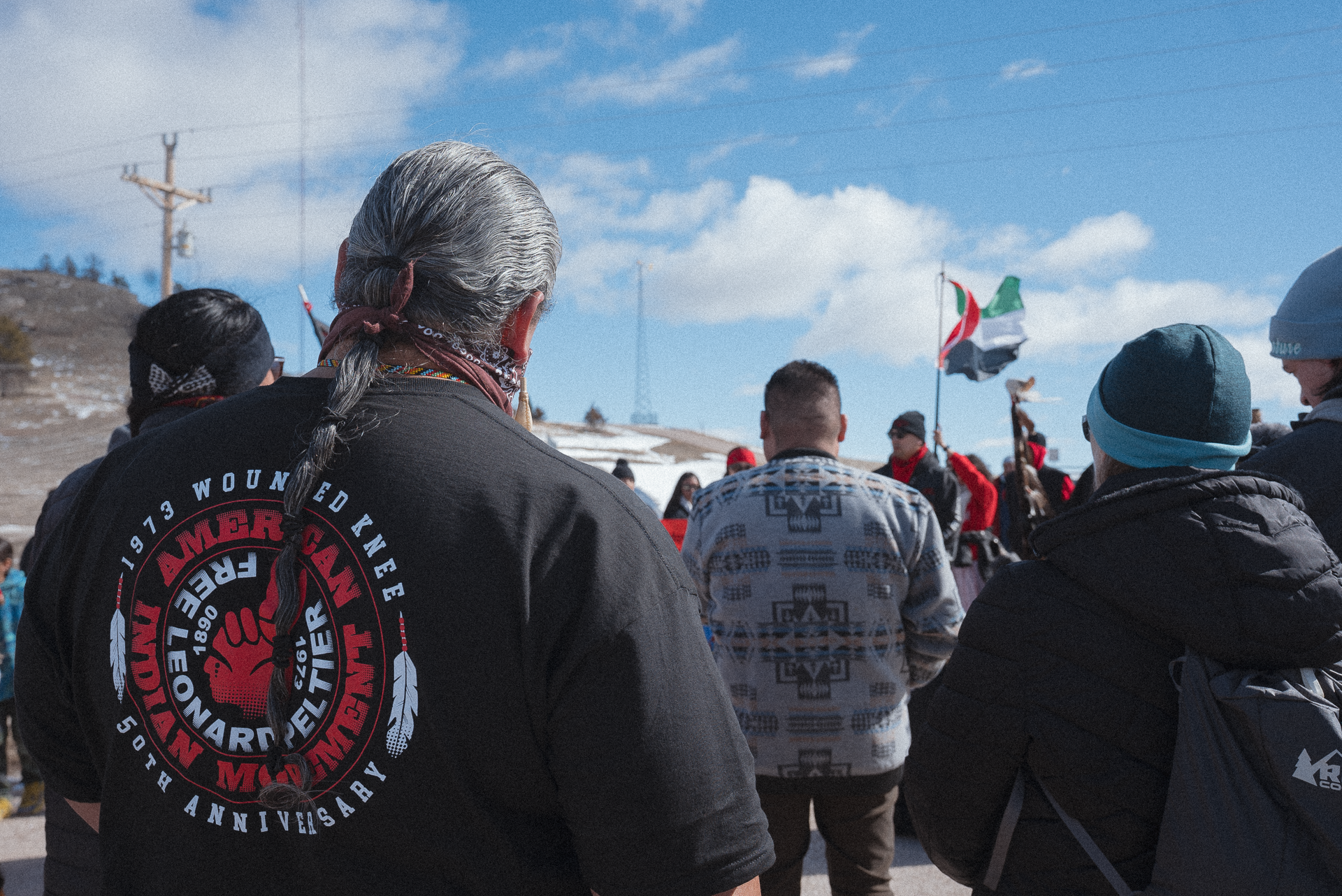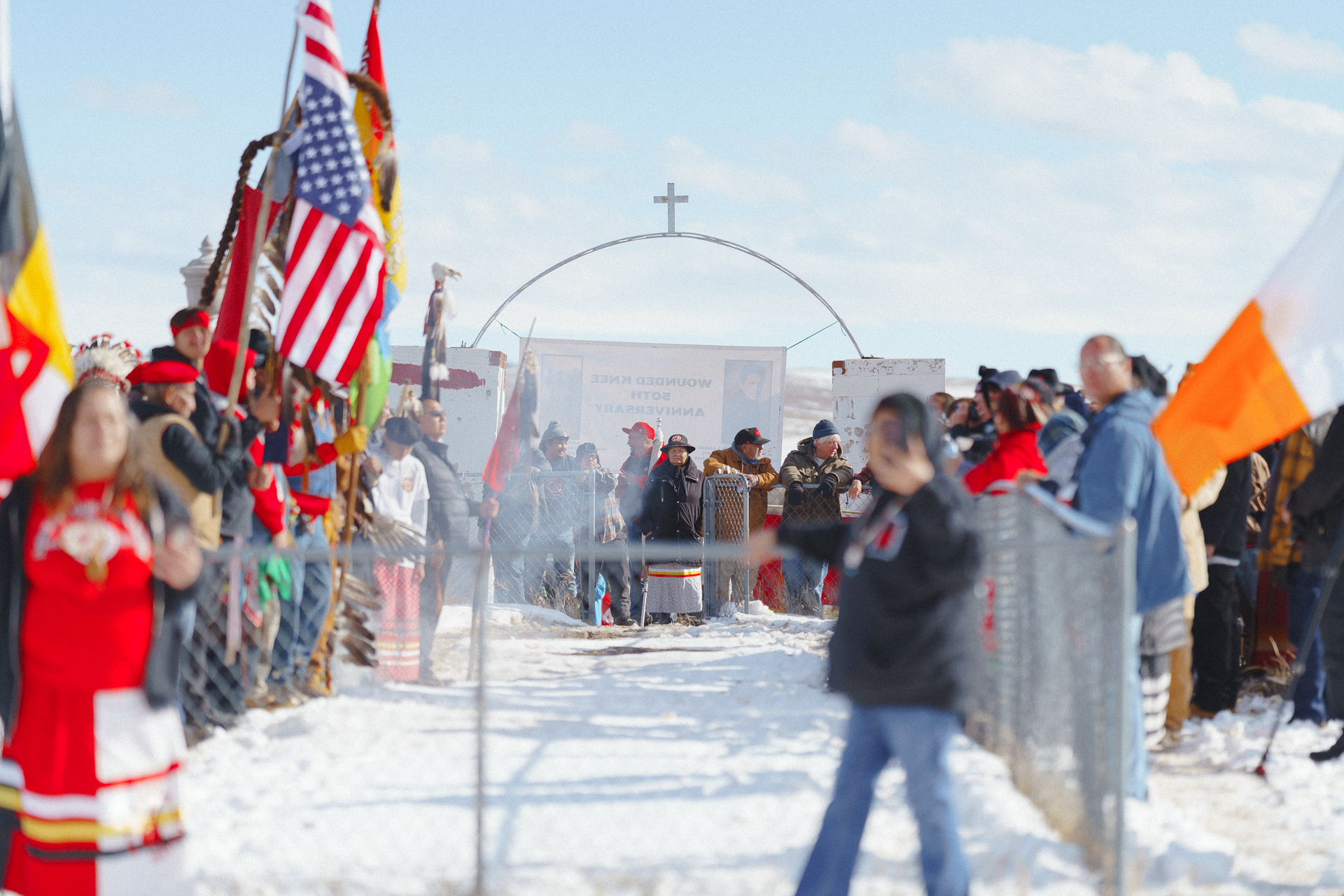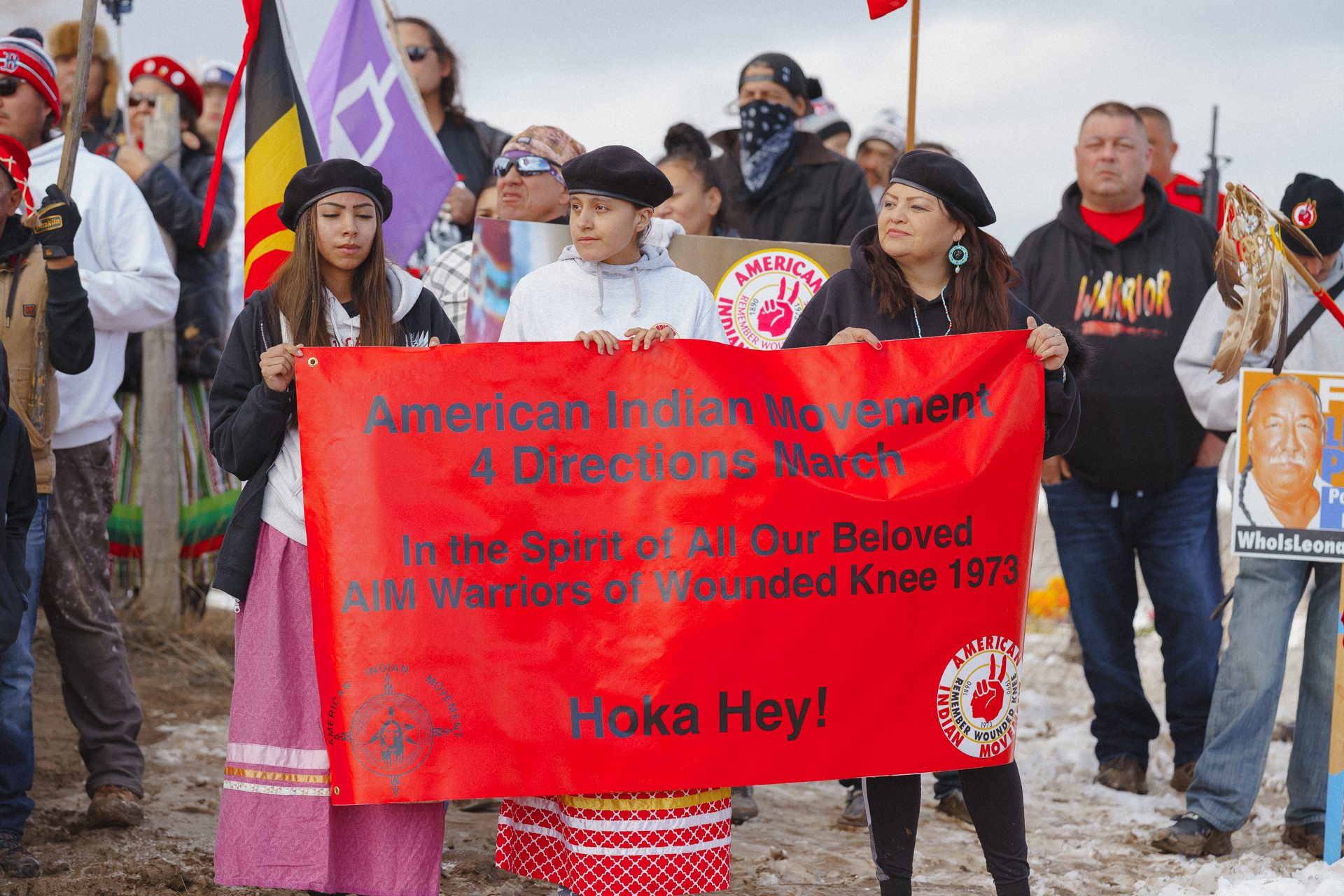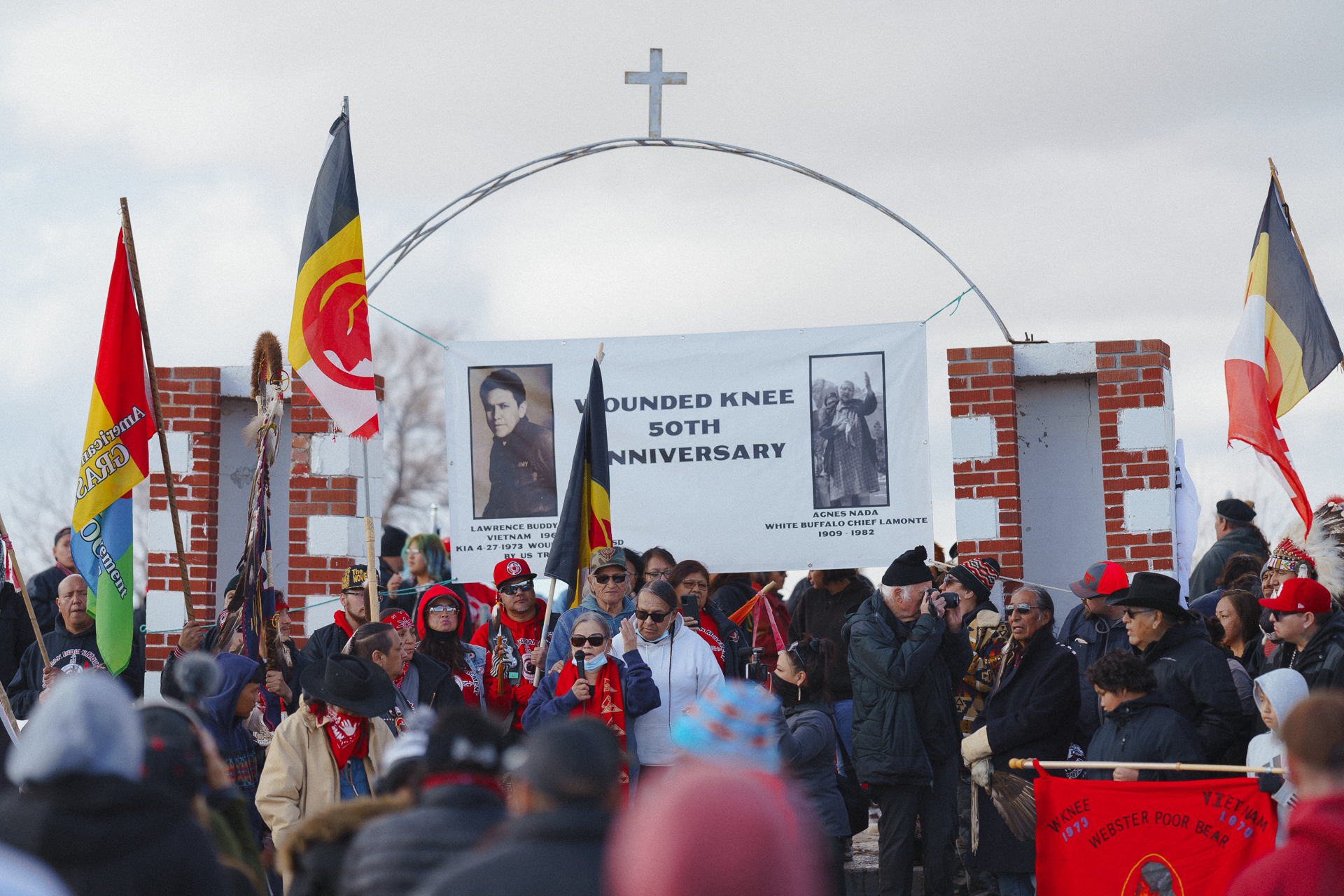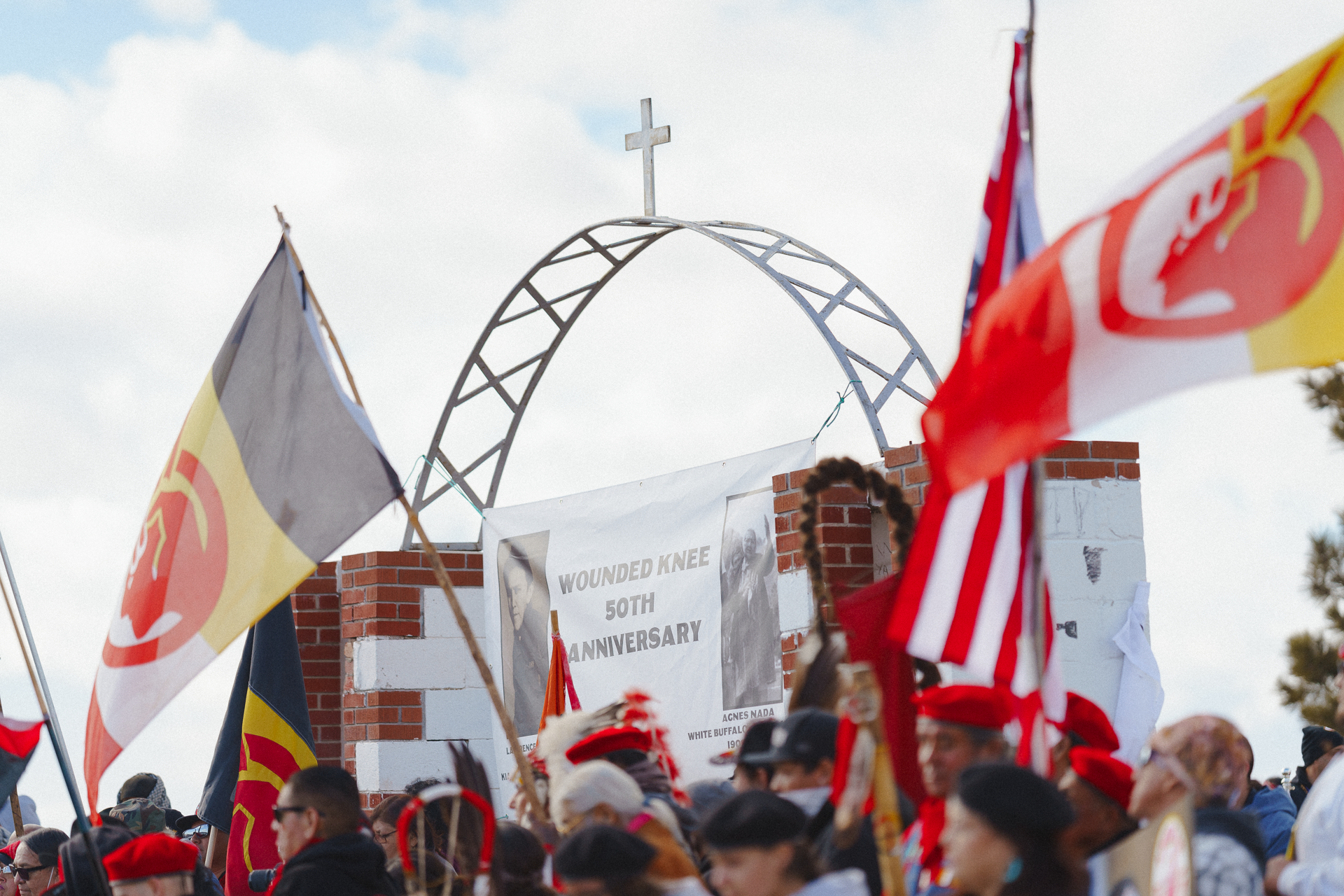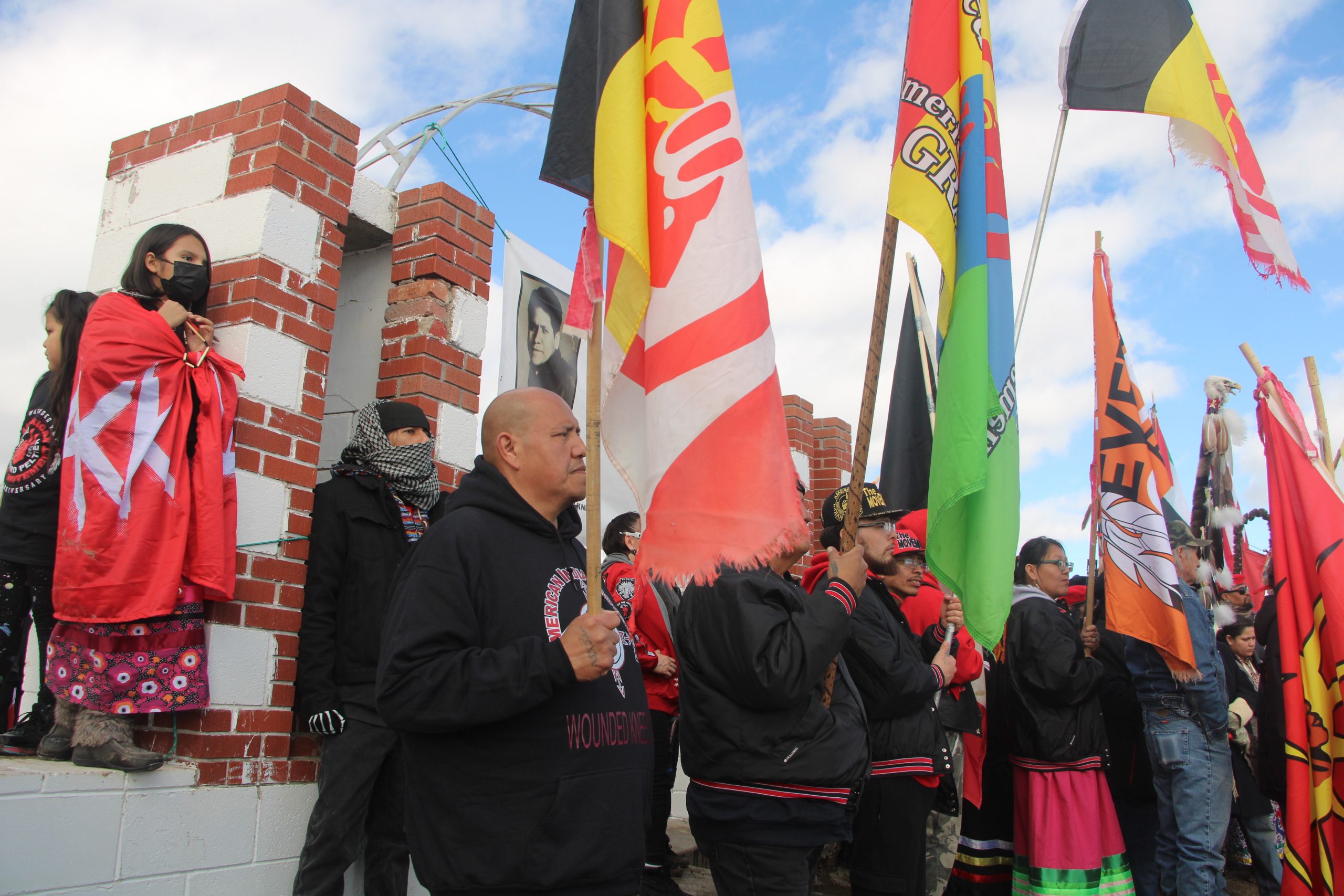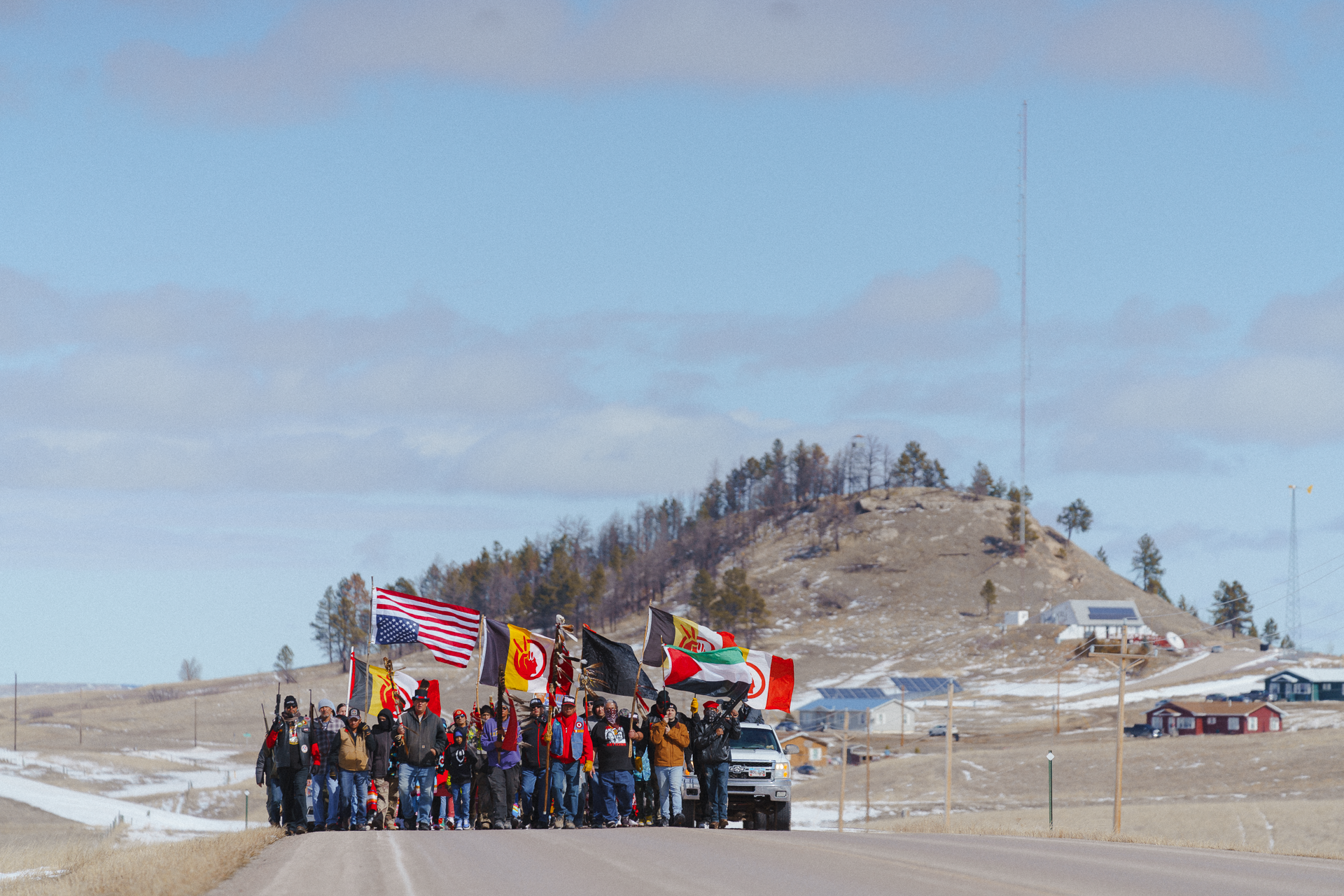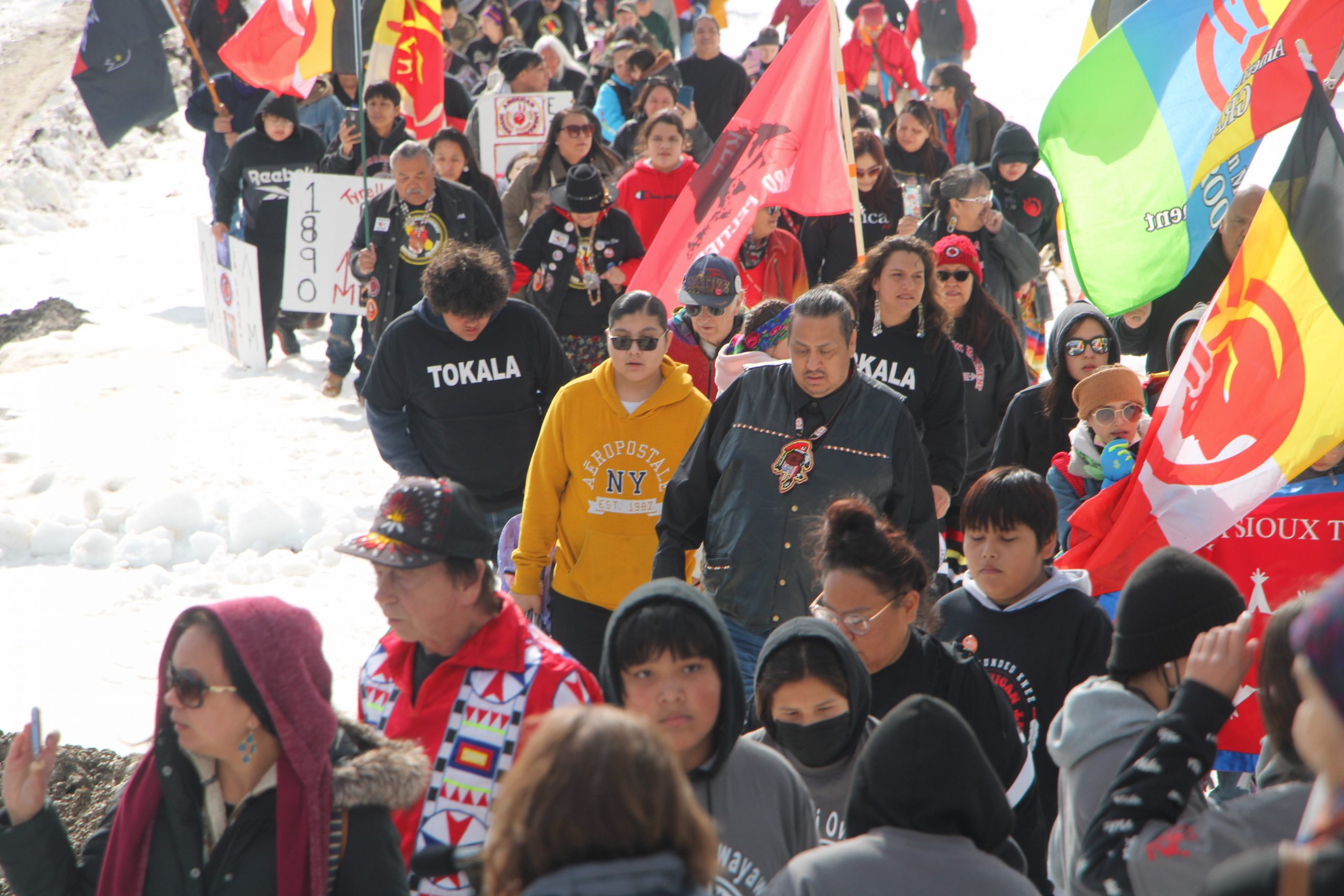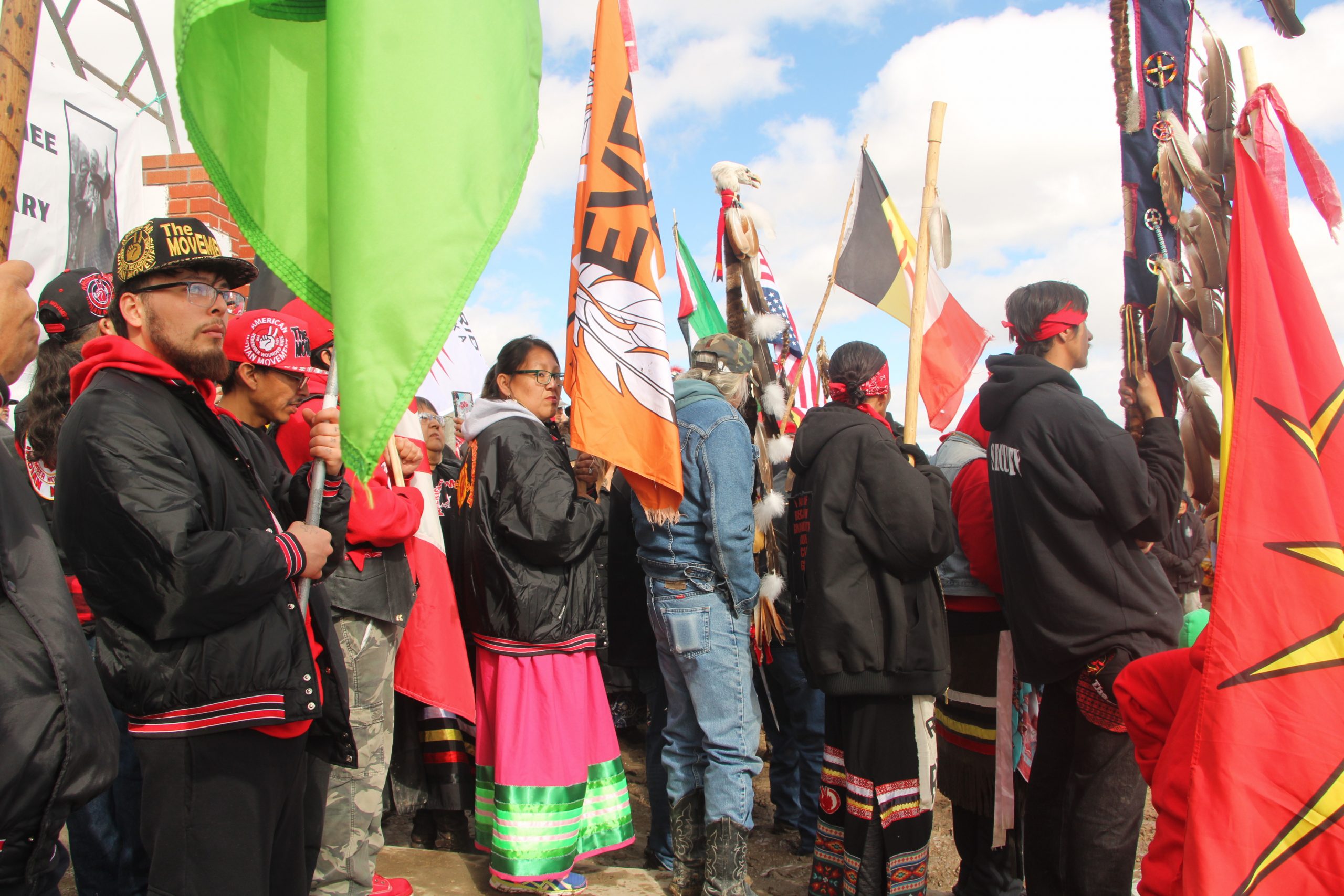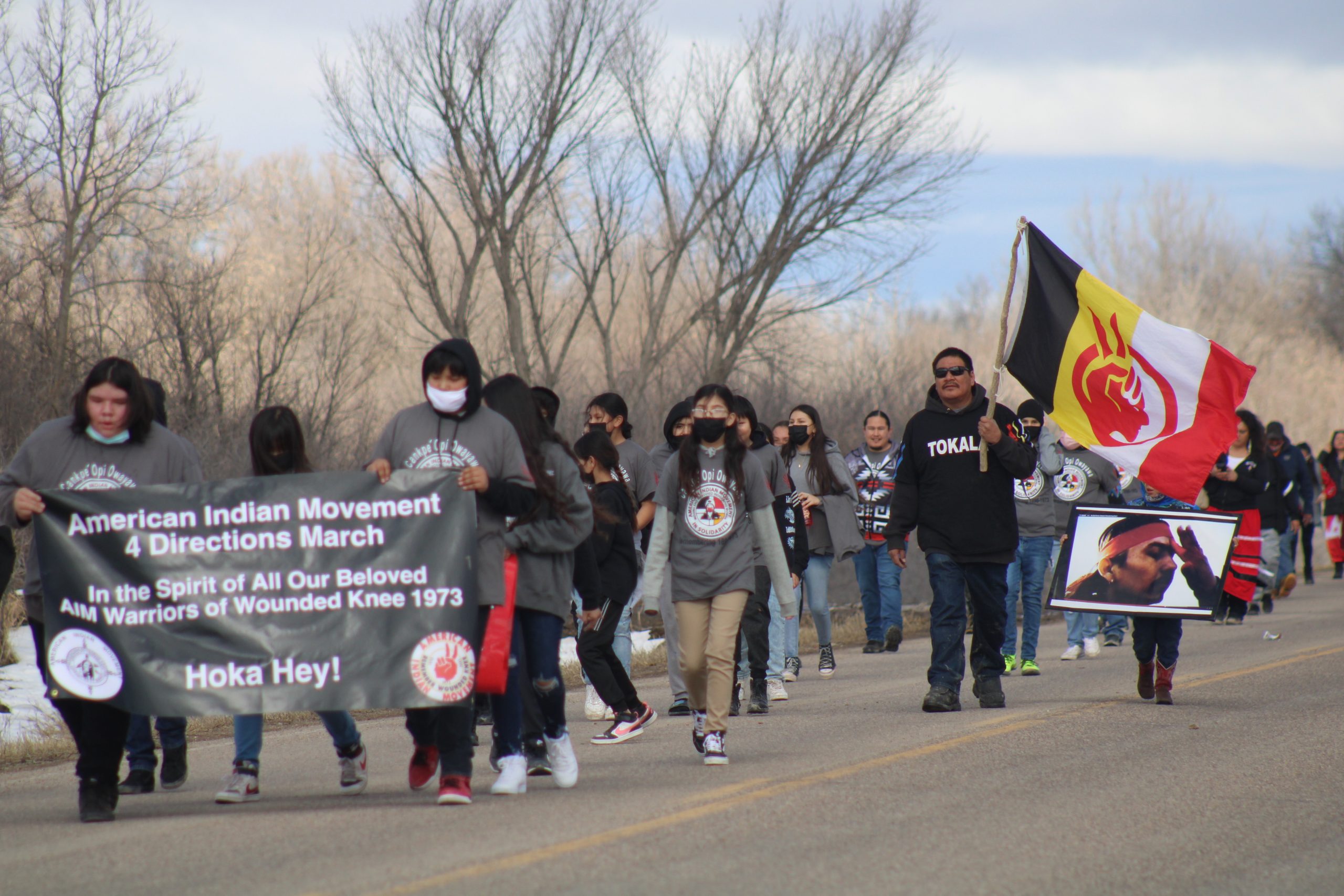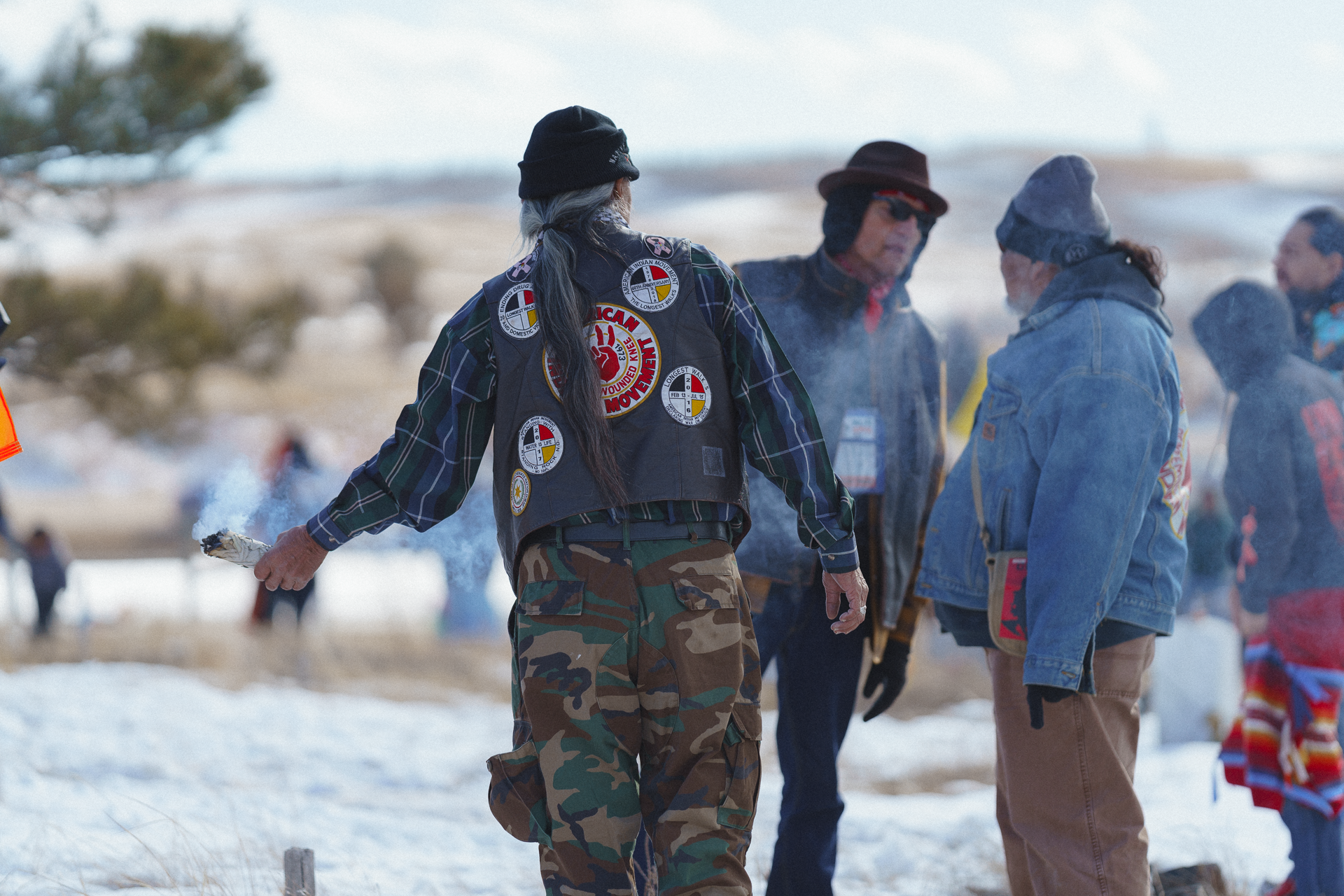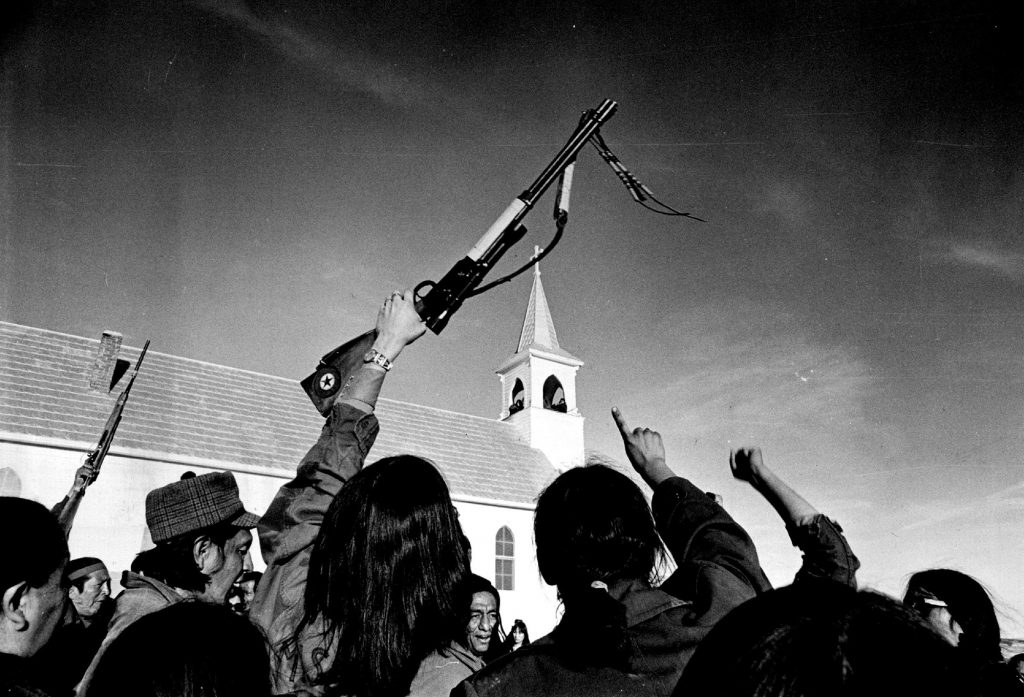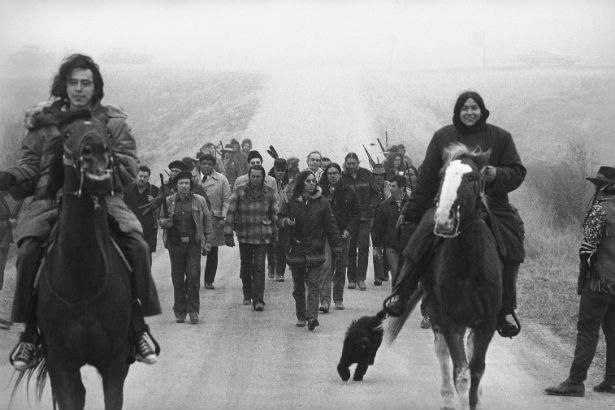On Monday, February 27, NDN Collective joined hundreds of Indigenous Relatives and allies on Oglala Lakota lands for the 50th commemoration of Liberation Day and the 1973 Occupation of Wounded Knee. With songs that traveled in all directions, the group marched alongside members of the community and the American Indian Movement (AIM) in honor of those who rose up during the Wounded Knee occupation.
AIM members would occupy Wounded Knee for 71 days in 1973, in protest of growing treaty rights violations, the violence occurring on Indigenous lands and the Pine Ridge Indian Reservation, and as an assertion of the inherent and sovereign rights of Indigenous Peoples. The American Indian Movement 4 Directions March set out to honor the power and resilience of movement warriors, past, present, and future.
“It’s been fifty years since the Occupation of Wounded Knee and there is a heavy, but excited feeling in the air,” said Mark Tilsen (Oglala Lakota), NDN Action Organizer. “Many of the Veterans of ’73 have come back here for the first time since the occupation. There is some nostalgia in the air as old friends, now with silver, grey, and white in their hair, swap war stories, and their grandchildren meet and play together. This also carries the weight of history, absent friends too infirm to attend and warriors no longer with us.”
Mark and his siblings are products of the American Indian Movement generation, affectionately known by many as “AIM babies” who grew up watching the movement happen all around them.
“I grew up in the shadow of these towering figures and I’m still wrapping my head around that these elders who will pass on, and how it will be my turn to tell the story of what happened here,” said Mark. “There are profound lessons learned from Wounded Knee, ones we can hand down to the generations that come after us: When the people stand together, we can win. Our resistance inspires others. Even going to war can be a prayer.”
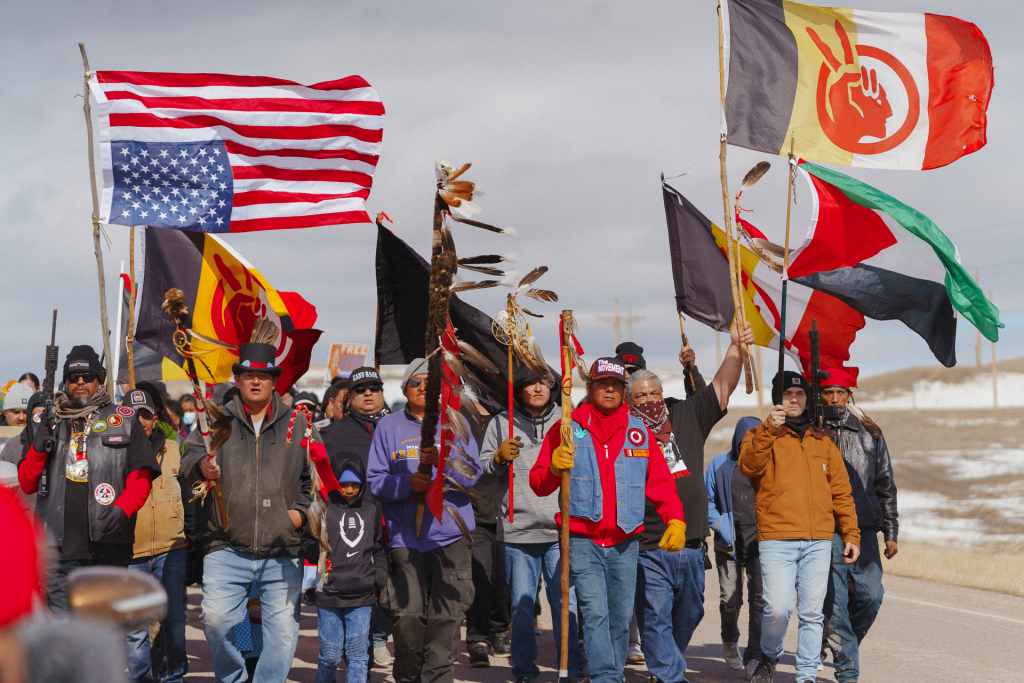
In 1973, Gladys and Pedro Bisonette, leadership of the Oglala Civil Rights Organization on the Pine Ridge Indian Reservation, extended the invitation to AIM to come to Pine Ridge following the murder of Raymond Yellow Thunder. The American Indian Movement came to answer the calls for Justice.
The Occupation of Wounded Knee ensued following a series of related events, including the Trail of Broken Treaties, that were organized by AIM leaders throughout the 1970s. In a grassroots effort, AIM organized to bring national attention to the injustices being inflicted on Indigenous Peoples by federal government and state agencies.
A prayer was made in 1973, and here we are today.
Andrew Catt-IronShell, NDN Action Organizer
At the time, growing tensions between Oglala Tribal President Dick Wilson and the community of Pine Ridge would also add to the events that would transpire at Wounded Knee. Wilson utilized the force of his private paramilitary group commonly known as the Guardians of the Oglala Nation (GOONs) to keep AIM members from entering the community. Together with U.S. marshals, military, and the FBI, the GOONs created a blockade preventing supplies, media, and allies from reaching AIM members and allies at Wounded Knee.
“I came to Liberation Day today for several reasons,” said Nick Tilsen (Oglala Lakota), NDN Collective President and CEO. “The main one was to pay respect to the warriors, men, women, and relatives that have fought the battles before. Those who made the stand at Wounded Knee in 1973, who occupied Alcatraz Island, who led the Trail of Broken Treaties, and those who led the takeover of the B.I.A. headquarters.”
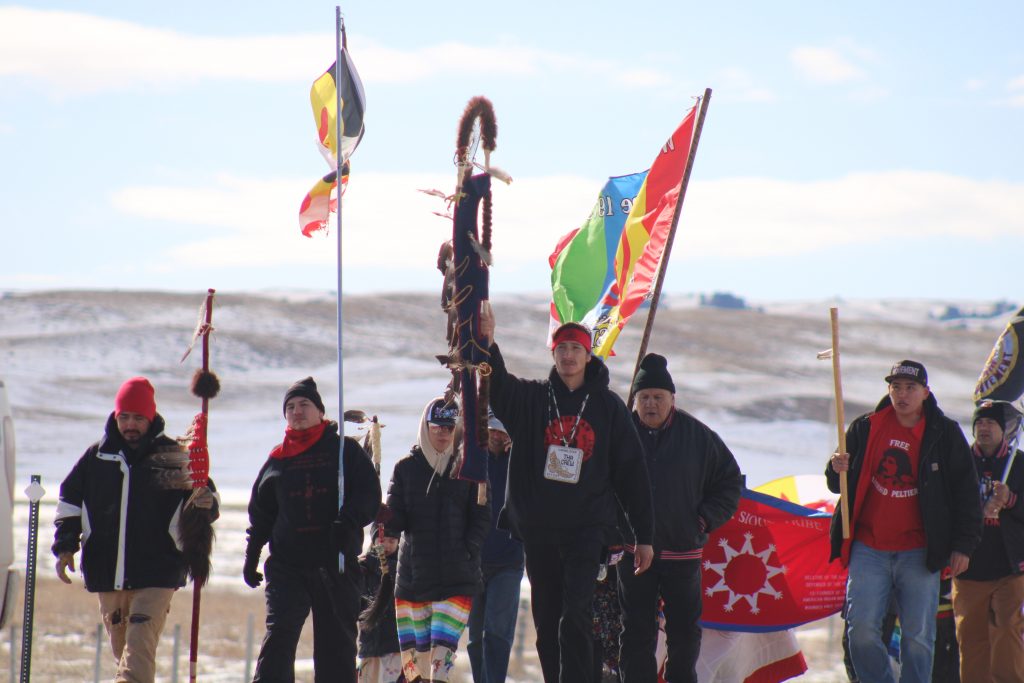
“Those moments in history sparked a change throughout the Indigenous world about Indigenous liberation, Indigenous self-determination, and Indigenous sovereignty. The work that we continue now would not be possible without the sacrifice and commitment of all the warriors at Wounded Knee in 1973 and all of the American Indian Movement.”
Nick, like his brother Mark, is also an “AIM baby.” Both their mother and father, Joann Tall and Mark Tilsen, Sr., were present at the 1973 occupation of Wounded Knee– Tall, being a longtime grassroots community organizer on Pine Ridge and also advocating for human rights on an international level. Both Joann Tall and Mark Tilsen, Sr. later became founding members of KILI Radio on the Pine Ridge Indian Reservation.
In all of his work, NDN Collective President and CEO Nick Tilsen has carried on the same spirit of Indigenous resistance and movement-building, being inspired by the era of his parents.
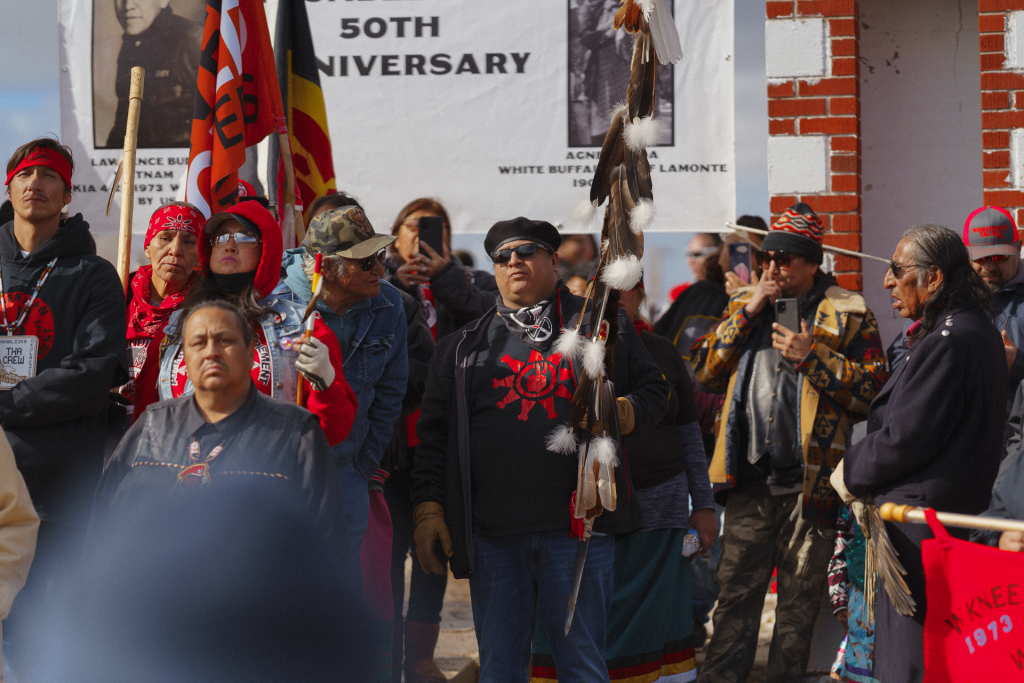
“There would not be an NDN Collective if there was never an American Indian Movement (AIM), or if there was never Wounded Knee in 1973,” said Nick. “At the event commemorating the 50th anniversary of Wounded Knee, which we acknowledge at NDN Collective as Liberation Day, we paid respects to that generation and to honor everything that happened there, the spiritual power and the awakening that happened for our people.”
“It felt powerful to be here,” Nick continued. “It was intergenerational with young and older relatives, those of us who grew up in the movement, and people who were fighting 50 years ago, who are still here today, fighting for change.”
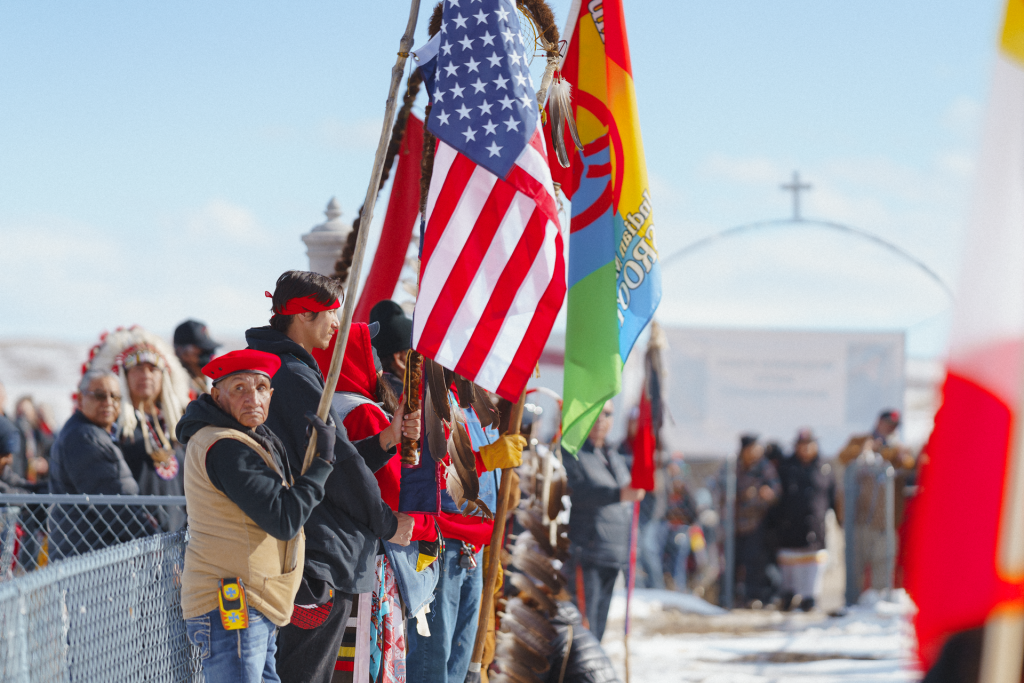
“Today at the ceremony, I was standing next to my brother, my good comrade, and fellow warrior, Vick Camp. Both of us were reminiscing about how neither one of us would have been here at all but, it was because our families came together at Wounded Knee. That’s where our families met each other,” said Nick.
“Relationships formed there that created new families, and I was one of them. My mom’s side of the family and my dad’s side of the family, that’s where they met, at Wounded Knee in the midst of the movement and so it was a powerful day.”
The work that we continue now would not be possible without the sacrifice and commitment of all the warriors at Wounded Knee in 1973 and all of the American Indian Movement.
Nick Tilsen, NDN Collective PResident and CEO
“It felt important for me to be here,” said Nick. “These are my homelands, Oglala Lakota. They marched right past my land, my home in Porcupine. I waited there at the end of my road and joined the march with some of my family. It was really beautiful and the prayers were strong. It was important to watch, support, and reflect with the elders and warriors. To let them know that we wouldn’t be doing the work that we’re doing today, had it not been for their sacrifice and their commitment.”
“I was sitting there reflecting and it really got me choked up because my parents’ generation had to fight for the right to practice our ceremonies undisturbed. Me and my generation, we got to grow up in the ceremonies, we never had to fight for the right to practice those ceremonies because the generation before us fought and won that for us and so this generation could grow up living that way of life,” said Nick.
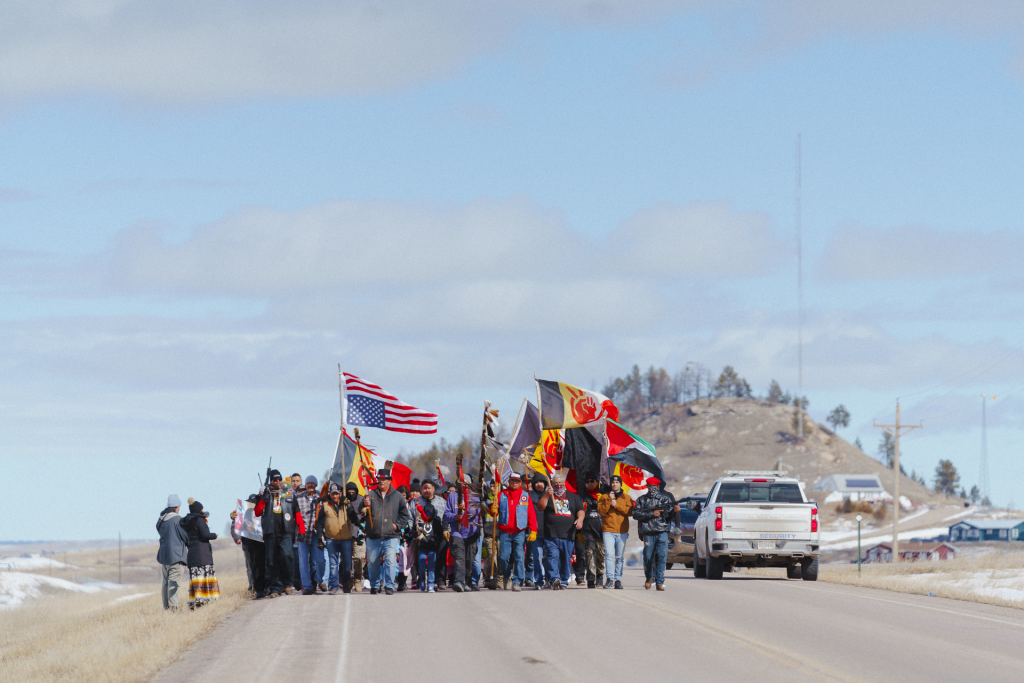
Sweeping federal policy changes eventually came as a result of the organizing work and mobilization of the American Indian Movement. Nick Tilsen remembers how AIM made this a reality.
“They reminded the world that we are still here, we have human rights, we have treaty rights, and that we have the right to human dignity,” said Nick. “As I reflect and think about the movement that we’re building, it’s a continuation and a continuum of Indigenous resistance. Celebrating these moments is really important because there are lessons learned from these movements. We need to take the lessons learned and use them to catalyze our movements for transformative and radical change. I’m fired up for Liberation Day to be celebrated for another 50 years.”
The 1973 occupation of Wounded Knee became the first Indigenous protest to be nationally reported on, reaching the homes of supporters and allies across the country. The unapologetic organizing of AIM members signaled that Indigenous Peoples would not remain silent and that we would rise up in defense of past and present atrocities being committed against our communities.
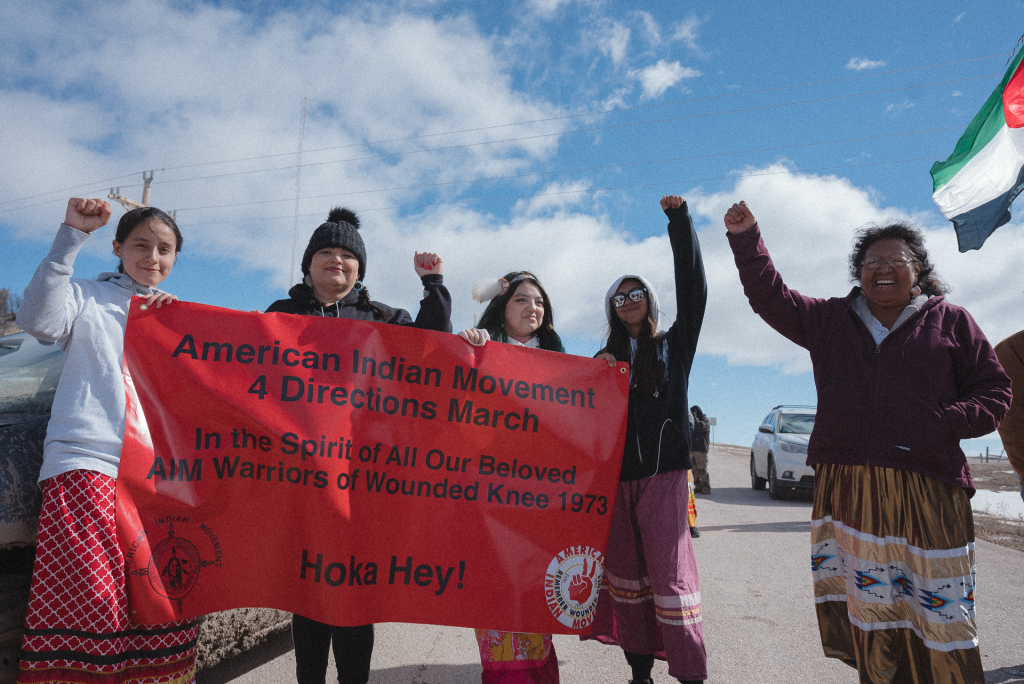
Today at Wounded Knee, there is a poignant energy imprinted on the land– A heaviness, remembering the 1890 Wounded Knee Massacre, where hundreds of Lakota people were brutally killed in the winter snow– and almost 100 years later in 1973, a bold reminder of an undying warrior spirit, as the American Indian Movement reclaimed the land and the site of the massacre as a place of Indigenous rights and empowerment.
“The survivors of Wounded Knee remain empowered and dedicated to the continuation of protecting sacred Indigenous land,” said Steph Viera (Diné), NDN Collective Associate Producer who was present at the event. “Today, they showed me that no matter your Nation, all Indigenous people have a place in the movement– that we are the movement.”
In many ways today, Wounded Knee signifies the sacrifices of past generations, the evolution of Indigenous resistance, and the power of Indigenous people when we are united. The AIM 4 Directions March, commemorating Liberation Day and the Occupation of Wounded Knee, also reminds us of the strength and hope that lies ahead.
“The youth led the way today and made the grandmas and grandpas smile. They made the ancestors smile,” said Andrew Catt-Iron Shell (Eastern Band of Cherokee Indians), NDN Action Organizer. “At one time, a prayer was made by all of them for the youth. A prayer was made in 1973, and here we are today. Indigenous youth making no apologies for the power they are about to unleash. For the Indigenous, our best days are ahead of us.”
Watch the Full NDN Live: 50th Anniversary Wounded Knee Liberation 4 Directions March
More Photos from the American Indian Movement 4 Directions March
Click on photos to expand
